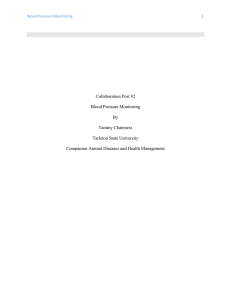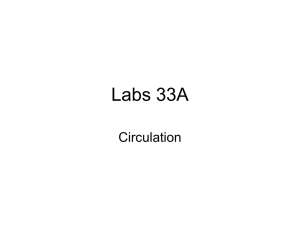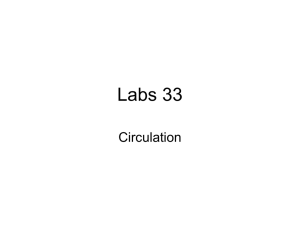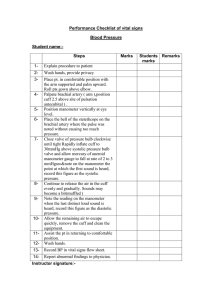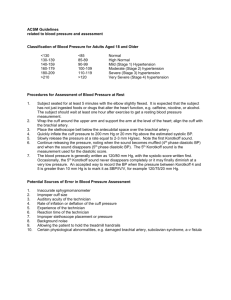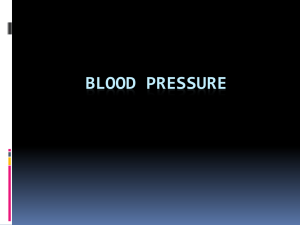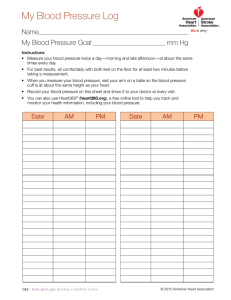Auscultatory and Oscillometric methods of Blood pressure
advertisement
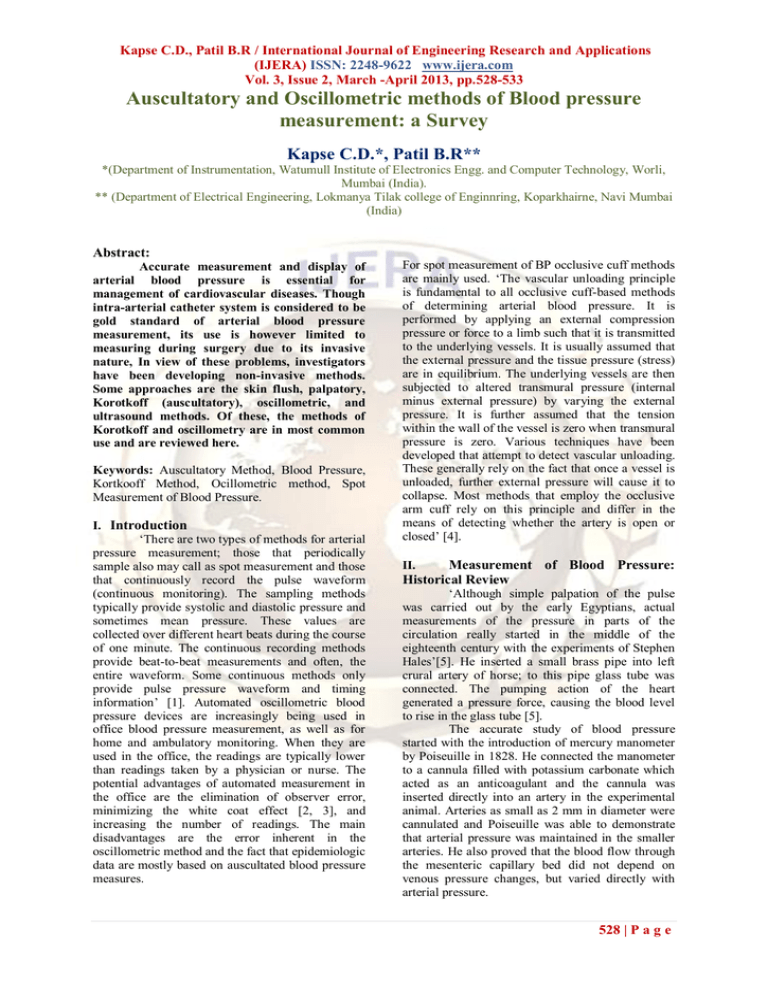
Kapse C.D., Patil B.R / International Journal of Engineering Research and Applications (IJERA) ISSN: 2248-9622 www.ijera.com Vol. 3, Issue 2, March -April 2013, pp.528-533 Auscultatory and Oscillometric methods of Blood pressure measurement: a Survey Kapse C.D.*, Patil B.R** *(Department of Instrumentation, Watumull Institute of Electronics Engg. and Computer Technology, Worli, Mumbai (India). ** (Department of Electrical Engineering, Lokmanya Tilak college of Enginnring, Koparkhairne, Navi Mumbai (India) Abstract: Accurate measurement and display of arterial blood pressure is essential for management of cardiovascular diseases. Though intra-arterial catheter system is considered to be gold standard of arterial blood pressure measurement, its use is however limited to measuring during surgery due to its invasive nature, In view of these problems, investigators have been developing non-invasive methods. Some approaches are the skin flush, palpatory, Korotkoff (auscultatory), oscillometric, and ultrasound methods. Of these, the methods of Korotkoff and oscillometry are in most common use and are reviewed here. Keywords: Auscultatory Method, Blood Pressure, Kortkooff Method, Ocillometric method, Spot Measurement of Blood Pressure. I. Introduction „There are two types of methods for arterial pressure measurement; those that periodically sample also may call as spot measurement and those that continuously record the pulse waveform (continuous monitoring). The sampling methods typically provide systolic and diastolic pressure and sometimes mean pressure. These values are collected over different heart beats during the course of one minute. The continuous recording methods provide beat-to-beat measurements and often, the entire waveform. Some continuous methods only provide pulse pressure waveform and timing information‟ [1]. Automated oscillometric blood pressure devices are increasingly being used in office blood pressure measurement, as well as for home and ambulatory monitoring. When they are used in the office, the readings are typically lower than readings taken by a physician or nurse. The potential advantages of automated measurement in the office are the elimination of observer error, minimizing the white coat effect [2, 3], and increasing the number of readings. The main disadvantages are the error inherent in the oscillometric method and the fact that epidemiologic data are mostly based on auscultated blood pressure measures. For spot measurement of BP occlusive cuff methods are mainly used. „The vascular unloading principle is fundamental to all occlusive cuff-based methods of determining arterial blood pressure. It is performed by applying an external compression pressure or force to a limb such that it is transmitted to the underlying vessels. It is usually assumed that the external pressure and the tissue pressure (stress) are in equilibrium. The underlying vessels are then subjected to altered transmural pressure (internal minus external pressure) by varying the external pressure. It is further assumed that the tension within the wall of the vessel is zero when transmural pressure is zero. Various techniques have been developed that attempt to detect vascular unloading. These generally rely on the fact that once a vessel is unloaded, further external pressure will cause it to collapse. Most methods that employ the occlusive arm cuff rely on this principle and differ in the means of detecting whether the artery is open or closed‟ [4]. Measurement of Blood Pressure: Historical Review II. „Although simple palpation of the pulse was carried out by the early Egyptians, actual measurements of the pressure in parts of the circulation really started in the middle of the eighteenth century with the experiments of Stephen Hales‟[5]. He inserted a small brass pipe into left crural artery of horse; to this pipe glass tube was connected. The pumping action of the heart generated a pressure force, causing the blood level to rise in the glass tube [5]. The accurate study of blood pressure started with the introduction of mercury manometer by Poiseuille in 1828. He connected the manometer to a cannula filled with potassium carbonate which acted as an anticoagulant and the cannula was inserted directly into an artery in the experimental animal. Arteries as small as 2 mm in diameter were cannulated and Poiseuille was able to demonstrate that arterial pressure was maintained in the smaller arteries. He also proved that the blood flow through the mesenteric capillary bed did not depend on venous pressure changes, but varied directly with arterial pressure. 528 | P a g e Kapse C.D., Patil B.R / International Journal of Engineering Research and Applications (IJERA) ISSN: 2248-9622 www.ijera.com Vol. 3, Issue 2, March -April 2013, pp.528-533 Based on Poiseuille‟s innovations, Carl Ludwig developed kymograph in 1847. He used the cannula and mercury manometer same as that was used in Poiseuille‟s equipment, but a float with a writing pen attached was buoyed up by the open mercury column and the pen arranged to write on a revolving, smoked drum. This was the first attempt to record the blood pressure. First non-invasive method was introduced in 1855. Vierordt postulated that an indirect, noninvasive technique might be used, by measuring the counter pressure which would be necessary to cause the pulsation in an artery to cease. In order to support this theory, Vierordt attempted to measure the pressure which was needed to cause obliteration of the radial pulse, by a weight attached to the lever of a sphygmograph. „He did not, however, meet with very much success, due largely to the cumbersome design of his apparatus. His sphygmograph was considerably improved by Etienne Jules Marey in 1860. Marey applied Vierordt's principle of applying counter pressure to overcome the arterial pressure, but, in his apparatus the arm was enclosed in a glass chamber filled with water, which was connected both to a sphygmograph and to a kymograph which recorded the arterial pulsations in the arm. The chamber was also supplied with a moveable reservoir of water so that the pressure in it could be varied, and with a manometer. The determination of the blood pressure was done by first noting the pressure given by the mercury manometer at which the greatest peak to peak distance of the sphygmographic tracings occurred, and then gradually increasing the pressure by raising the reservoir. The pressure at which no more movement of the sphygmograph took place was recorded as the systolic pressure. Although Marey's device was a masterpiece of ingenuity, it was far too complicated for most doctors to use routinely‟ [5]. „In 1896, Riva-Rocci reported the method upon which present-day technique is based. In his technique a rubber bag, surrounded by a cuff of some inexpansible material, was wrapped round the arm and was inflated with air by means of an attached rubber bulb. The pressure in the cuff was registered by the usual mercury manometer, and was increased until the radial pulse could no longer be palpated. When the pressure was slowly released the mercury level in the manometer fell, and the reading at which the pulse reappeared was taken as the systolic blood pressure. There was, however, one main defect in Riva-Rocci's method; he used a narrow cuff only 5 cm wide. This caused an acute angle to form between the upper and lower edges of the cuff and the skin, which resulted in local areas of high pressure building up and rendering the reading mildly inaccurate. This error was realized and corrected by von Recklinghausen in 1901, who replaced the narrow armband with a wider one (12 cm)‟[5]. In 1905, N C Korotkoff, a Russian army physician, reported that by placing a stethoscope over the brachial artery at the cubital fossa, distal to the Riva-Rocci cuff, tapping sounds could be heard as the cuff was deflated, caused by blood flowing back into the artery. This was the start of auscultatory method of blood pressure measurement. „Kortkoff‟s important contribution to medicine was the devising of an accurate and easy method of determining the blood pressure. His technique has stood the test of time as it has been used for more than a century with practically no changes made to it‟. Kortkoff laid the foundation from which many investigators worked on [6-9]. The pneumatic sleeve or cuff, also referred to as a tourniquet, consisted usually of a rubber bladder woven inside a fabric. It enabled indirect, noninvasive arterial blood pressure measurement. Till today, the cuff has been the single most important component of noninvasive blood pressure measurement devices. The cuff is usually attached around the arm, wrist or a finger. Pressure measurements can be made by using a mercury or aneroid manometer. These are now being replaced with silicon-based pressure sensors inside automatic measurement devices, based usually on the auscultatory or oscillometric method. These devices may replace conventional mercury and aneroid manometers in future [10]. III. Spot Measurement of Blood Pressure Auscultatory Method: In 1905, N C Korotkoff, a Russian army physician, reported that by placing a stethoscope over the brachial artery at the cubital fossa, distal to the Riva-Rocci cuff, tapping sounds could be heard as the cuff was deflated, caused by blood flowing back into the artery. Korotkoff sounds were corroborated by the British researchers MacWilliam et al. in 1914 [6] and the American, Warfield in 1912 [7], who used intra-arterial pressure measured from a dog as a reference. In 1932, von Bonsdorff validated Korotkoff‟s auscultatory method on humans using intra-arterial blood pressure as a reference [8]. Later, the characteristic sounds heard during cuff deflation were divided into five phases on the basis of their intensity. First to publish were Goodman and Howell (1911), followed by Grodel and Miller (1943), Korns (1926) as well as Rappaport, Luisada (1944) and O‟Brien et al. [11] in 1979. The method, as employed today, utilizes a stethoscope placed distal to an arm cuff over the brachial artery at the antecubital fossa. The cuff is inflated to about 30 mm Hg above systolic pressure and then allowed to deflate at a rate of 2 to 3 mm Hg/s. With falling cuff pressure, sounds begin and slowly change their characteristics. The initial 529 | P a g e Kapse C.D., Patil B.R / International Journal of Engineering Research and Applications (IJERA) ISSN: 2248-9622 www.ijera.com Vol. 3, Issue 2, March -April 2013, pp.528-533 “tapping” sounds are referred to as Phase I Korotkoff sound and denote systolic pressure. The sounds increase in loudness during Phase II. The maximum intensity occurs in Phase III, where the tapping sound may be followed by a murmur due to turbulence. Finally, Phase IV Korotkoff sound is identified as muffled sound, and Phase V is the complete disappearance of sound. Phase IV is generally taken to indicate diastolic arterial pressure. However, Phase V has also been suggested to be a more accurate indication of diastolic pressure. Pressures are recorded to the nearest 2 mm Hg. When all sounds have disappeared the cuff should be deflated rapidly and completely before repeating the measurement to prevent venous congestion of the arm. „At an initial examination blood pressure needs to be measured in both arms. If the difference between arms is more than 10 mm Hg for either systolic or diastolic pressure, the arm with the higher pressure is used for future measurements. Ideally, records of blood pressure measurement (a) should show the systolic pressure, the diastolic pressure, the endpoint used, the limb used and whether right or left, the position of the patient, and the presence of any arrhythmias or unusual circumstances such as anxiety or confinement to bed‟ [11, 12]. The Phase III sound can be used to determine mean arterial blood pressure, as demonstrated by Davis and Geddes [13]. Figure 1 shows mercury sphygmomanometer, placement of cuff and stethoscope. Measurements based on the auscultatory method are difficult to automate, because the frequency spectrum of the different phases of Korotkoff sounds is closely related to blood pressure. When a patient‟s blood pressure is high, also the recorded frequency spectrum is higher than normal and decreases as a function of blood pressure. With hypotensive patients and infants, on the other hand, the highest spectrum components can be as low as 8 Hz, which is below the human hearing bandwidth [14]. (b) Figure 1: (a) Mercury Sphygmomanometer; (b) Placement of cuff and stethoscope Normotensive subjects, in turn, require a bandwidth of 20 Hz to 300 Hz for a sufficient reproduction of Korotkoff sounds, although most of the energy of the signal spectrum is below 100 Hz. Since technology improvements have enabled efficient signal processing and calculation, a number of papers have been published on the classification of Korotkoff sounds. Cozby and Adhami [15], for example, discovered the sub-audible, low frequency part of Korotkoff sounds and concluded that energy in the 1-10 Hz bandwidth of the total energy rises from 60% to 90%, when cuff pressure decreases from above the systolic to a level below it. This feature can be used as a thresholding algorithm for determining systolic blood pressure. RegueiroGomez and Pallas-Areny [16] were able to use the spectral energy dispersion ratio to determine systolic, diastolic and mean blood pressure with high precision. In ambulatory measurements, when the patient is able to move moderately, noise may become dominant, thereby spoiling the measurement. This may be avoided by using two identical microphones under the cuff, one located on the upper side, the other on the distal side. Ambient noise reaches both microphones at the same time, but the blood pressure pulse propagating through the brachial artery arrives after a time delay. This phenomenon can be used for noise cancellation as described by Sebald et al. [17]. Allen et al. [18] used a Matlab based shortterm time-frequency analysis to obtain spectral information of Korotkoff sounds. Their results show that phase III has the largest overall amplitude and high frequency energy. In contrast, phases IV and V have the lowest amplitude and frequency components. Statistically significant transitions were observed between the different phases; the transition from phase I to II was characterized by increase in high frequency and sound duration, the transition from phase II to III by a significant decrease in sound duration, the transition from phase III to IV by decrease in maximum amplitude, highest frequency and relative high frequency energy, and the transition from phase IV to V by decrease in the maximum amplitude and high frequency energy. 530 | P a g e Kapse C.D., Patil B.R / International Journal of Engineering Research and Applications (IJERA) ISSN: 2248-9622 www.ijera.com Vol. 3, Issue 2, March -April 2013, pp.528-533 They concluded that the method was able to detect the five phases also identified by an expert cardiologist, verifying that the method can be used in automatic blood pressure measurements. Oscillometric Method: The oscillometric method was first introduced by Marey in 1876. Erlanger (1904) further improved by attaching a Riva-Rocci cuff around the upper arm. Pressure oscillations were recorded on a rotating drum. Later Pachon (1909) used dual-dial gauges, one for presenting oscillation amplitude and the other for showing cuff pressure. In those days, it was thought that maximum oscillation amplitude indicated diastolic blood pressure. Marey (1885) placed the arm within a compression chamber and observed that the chamber pressure fluctuated with the pulse. He also noted that the amplitude of pulsation varied with chamber pressure. Marey believed that the maximum pulsations or the onset of pulsations were associated with equality of blood pressure and chamber pressure. At that time, he was not certain what level of arterial pressure the maximum pulsations corresponded with [1]. It has been theoretically shown that the variation in cuff pressure pulsation is primarily due to the brachial artery buckling mechanics [4]. Today, oscillometry is performed using a standard arm cuff together with an in-line pressure sensor. Due to the requirement of a sensor, oscillometry is generally not performed manually, but, rather, with an automatic instrument. The recorded cuff pressure is high-pass-filtered above 1 Hz to observe the pulsatile oscillations as the cuff slowly deflates. It has been established that the maximum oscillations actually correspond with cuff pressure equal to mean arterial pressure, confirming Marey‟s early idea. Systolic pressure is located at the point where the oscillations, are a fixed percentage of the maximum oscillations [1]. The majority of non-invasive automated blood pressure measuring devices currently available, use the oscillometric method based on empirically derived algorithms, generally patent protected, which calculate systolic and diastolic BP. Diastolic and systolic blood pressures can be determined using special fractions of the maximum oscillation amplitude, also known as characteristic ratios. There are no definite correct values for the systolic and diastolic characteristic ratios; rather different manufactures use different values. Theoretical and experimental work has suggested the following values for characteristic ratios; (a) Systolic from 0.46 to 0.64 and diastolic from 0.59 to 0.80 (theoretical work by Ursino and Cristalli in 1996) (b) Systolic 0.593 and diastolic 0.717 (theoretical work by Drzewiecki et al. in 1994) (c) Systolic from 0.45 to 0.57 and diastolic from 0.69 to 0.89 (experimental work by Geddes et al. in 1982) (d) Systolic (mean and SD) equal to 0.49 (0.11) and diastolic equal to 0.72 (0.12) (experimental work by Amoore et al. in 2007) The oscillometric determination of MAP is more accurate than systolic and diastolic pressures [19]. Drzewiecki et al. in 1994 employed a model of oscillometry to evaluate the derivative of the oscillation amplitude curve with respect to cuff pressure. When this derivative is plotted against cuff pressure, it was found that it reaches a maximum positive value. This occurred when cuff pressure equals diastolic pressure. Additionally, the minimum negative value was found to occur at systolic pressure. The advantage of this approach is that the empirically based systolic and diastolic ratios are not necessary. This method is called as derivative oscillometry [1]. Traditionally, the arterial pulsations in oscillometric devices are picked up from the occluding cuff by means of a manometer. However, in some implications a photoelectric detection directly from the tissue (PPG) is also used. Other methods than pneumatic pulse sensing seem to have become more popular in the wrist BP devices [19]. IV. Discussion and Conclusion: The oscillometric method is increasingly used in blood pressure measurement. Due to the simplicity and reliability of this method, the oscillometric principle is employed in the majority of present-day automatic and semiautomatic noninvasive blood pressure monitors [19]. Automated devices may also offer the opportunity to avoid expensive and repetitive training of health care professionals in auscultation, which is necessary to reduce observer errors. Their use still requires careful patient evaluation for caffeine or nicotine use, selection of the correct cuff size, and proper patient positioning if accurate blood pressures are to be obtained. Devices are now available that can take a series of sequential readings and automatically average them. Automated devices provide timed printouts of BP, remove many of the sources of error associated with the conventional auscultatory technique, and thereby improve the overall accuracy of measurement, provided, that they themselves are accurate. The accuracy and reliability of these devices may be questionable; these automated devices should be validated against standards. There are two published standards for the evaluation of automatic BP measuring devices, the American Association for the Advancement of Medical Instrumentation standard, and the more comprehensive protocol of British Hypertension 531 | P a g e Kapse C.D., Patil B.R / International Journal of Engineering Research and Applications (IJERA) ISSN: 2248-9622 www.ijera.com Vol. 3, Issue 2, March -April 2013, pp.528-533 Society. These protocols compare an automated BP measurement device against the traditional auscultatory technique of BP measurement in normotensive and hypertensive subjects with a wide range of BP in varying age groups. On the basis of these results, the protocols recommend that only those devices that achieve a high grade of accuracy for both systolic and diastolic BP should be recommended for clinical use [20]. [7] Warfield L. M., (1912), “Studies in Auscultatory Blood-Pressure Phenomena”, Arch. Inter. Med., vol. X(3), pp. 258-267. [8] James Bordley-III, Connor C. A. R., Hamilton W. F., Kerr W. J. and Wiggers C. J. (1951), “Recommendations for Human Blood Pressure Determinations by Sphygmomanometers”, Circulation, vol. IV, pp. 503-509. O'Brien E. T. and O'Aulley K. (1979), “ABC of Blood Pressure MeasurementReconciling the Controversies: a comment on the literature”, British Medical Journal, vol. 2, pp. 1201-1202. Tholl U., Forstner K. and Analauf M. (2004), “Measuring Blood Pressure: Pitfalls and Recommendations”, Nephrol Dial Transplant, vol. 19. pp 766-770. O'Brien E. T. and O'Aulley K. (1979), “ABC of Blood Pressure MeasurementTechnique”, British Medical Journal, vol. 2, pp. 982-984. Beevers G., Lip G. Y. H., O'Brien E. (2006), “ABC of Hypertension Blood Pressure Measurement: Part-II Conventional Sphygmo-manometry: Technique of Auscultatory Blood Pressure Measurement”, BMJ, vol. 322, pp. 10431047. Devis G. J. and Geddes L. A. (1990),” Auscultatory Mean Blood Pressure”, Journal of Clinical Monitoring, vol. 6, pp. 261-265. Blank S. G., West J. E., Muller F. B., Cody R. J., Harshfield G. A., Pecker M. S., Laragh J. H. and Pickering T. G. (1988), “Wideband External Pulse Recording During Cuff Deflation: A New Technique for Evaluation of The Arterial Pressure Pulse and Measurement of Blood Pressure”, Circulation, vol.77, pp. 12971305. Cozby R. C. and Adhami R. R. (1993), “Low-Frequency Korotkoff Signal Analysis and Application”, IEEE Transactions on Biomedical Engineering, vol. 40, no. 10, pp. 1067-1070. Regueiro A.-Gomez and Pallas R.-Areny (1996), “A New Indicator for Non-invasive Arterial Blood Pressure Measurement”, 18th Annual International Conference of the IEEE Engineering in Medicine and Biology Society, Amsterdam, pp. 117-118. Sebald D. J., Bahr D. E., Kahn A. R. (2002), “Narrowband Auscultatory Blood Pressure Measurement”, IEEE References: [1] Bronzino Joseph D., Editor (2000), “The Biomedical Engineering Hand Book”, Second Edition, CRC Press LLC, chapter no 71. [9] [2] Alcala F. V., Peralta J. L., Sanchez E. M., Montoro A. E., Dominguez A. C., and Chozas J. M. L. (2004), “Ambulatory Blood Pressure Monitoring to Study White Coat Effect in Patients with Hypertension Followed in Primary Care,” Hypertension , Rev Esp Cardiol , vol. 57, no. 7, pp. 652660. [10] [3] [4] Pickering T. G., Hall J. E., Appel L. J., Falkner B. E., Graves J., Hill M. N., Jones D. W., Kurtz T., Sheps S. G. and Roccella E. R. (2005), “Recommendations for Blood Pressure Measurement in Humans and Experimental Animals: Part 1: Blood Pressure Measurement in Humans: A Statement for Professionals from the Subcommittee of Professional and Public Education of the American Heart Association Council on High Blood Pressure Research”, Circulation, vol. 111, pp. 697-716. Drzewiecki G., Bansal V., Hood E. K. R., and Apple H. (1993), “Mechanics of the Occlusive Arm Cuff and Its Application as a Volume Sensor”, IEEE Transactions On Biomedical Engineering, vol. 40, no.7, pp. 704-708. [5] Booth Jeremy (1977), “A Short History of Blood Pressure Measurement”, Proc. Royal Society of Medicine, vol. 70, pp. 793-799. [6] Mac WILLIAM J. A., and Melvin S. P. (1914), “Systolic and Diastolic Blood Pressure Estimation, with Special Reference to the Auditory Method”, British Medical Journal, vol. March 1914, pp. 693-697. [11] [12] [13] [14] [15] [16] [17] 532 | P a g e Kapse C.D., Patil B.R / International Journal of Engineering Research and Applications (IJERA) ISSN: 2248-9622 www.ijera.com Vol. 3, Issue 2, March -April 2013, pp.528-533 Transactions on Biomedical Engineering, vol. 49, no. 9, pp. 1038-1044. [18] Allen J., Gehrke T., O'Sullivan J. J., King S. T. and Murray A. (2004), “Characterization of the Korotkoff Sounds using Joint Time-Frequency Analysis”, Physiological Measurement, vol. 25, no. 1, pp. 107. [19] Raamat R., Talts J., Jagomägi K. and Kivastik J. (2010), “Comparison of Oscillometric Pulse Amplitude Envelopes Recorded from the Locally Compressed Radial Arteries”, Medical Engineering and Physics, vol. 32, pp. 1124-1130. [20] O'Brien E., Beevers G., Lip G. Y. H. (2001), “ABC of Hypertension Blood Pressure Measurement, Part IV— Automated Sphygmomanometry: Self Blood Pressure Measurement”, BMJ, vol. 322, pp. 1167-1170. 533 | P a g e
